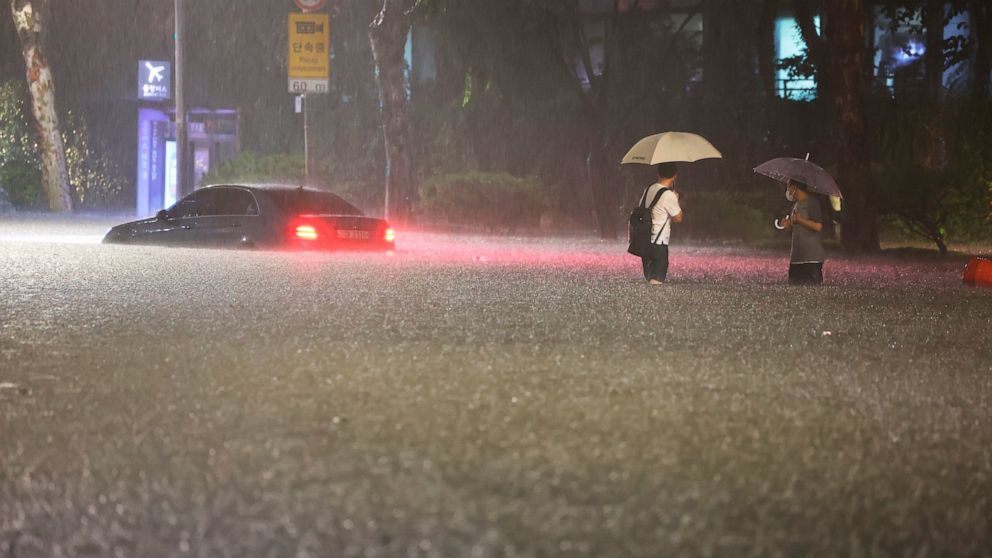
Comments
#Flood #victims #living #roads #Murad #Ali #Shah https://www.globalcourant.com/flood-victims-are-living-at-roads-says-cm-murad-ali-shah/?feed_id=15573&_unique_id=63073985edd8c


SEOUL, South Korea -- Heavy rains drenched South Korea’s capital region, turning the streets of Seoul’s affluent Gangnam district into a river, leaving submerged vehicles and overwhelming public transport systems. At least seven people were killed and six others were missing.
Commuters slowly returned to work Tuesday morning after emergency crews worked overnight to clean up much of the mess. But there were concerns about further damage as torrential rain was forecast for the second day in a row.
While most of the Seoul metropolitan area’s subway services were back to normal operations, around 80 roads and dozens of riverside parking lots remained closed due to safety concerns.
President Yoon Suk Yeol called for public employers and private companies to adjust their commuting hours and urged aggressive action in restoring damaged facilities and evacuating people in danger areas to prevent further deaths. Moon Hong-sik, spokesperson of Seoul’s Defense Ministry, said the military was prepared to deploy troops to help with recovery efforts if requested by cities or regional governments.
The rain began Monday morning and intensified through the evening hours. Nearly 800 buildings in Seoul and nearby cities were damaged while more than 400 people were forced to evacuate from their homes, the Ministry of the Interior and Safety said.
People were seen wading through thigh-high waters Monday night in streets near the Gangnam subway station, one of Seoul’s most bustling business and leisure districts, where passenger cars, taxis and buses were stuck in mud-brown waters. Commuters evacuated as water cascaded down the stairs of the Isu subway station like a waterfall. In the nearby city of Seongnam, a rain-weakened hillside collapsed into a university soccer field.
Rescue workers failed to reach three people who called for help before drowning in a basement home in the Gwanak district of southern Seoul Monday night. Another woman drowned at her home in the nearby Dongjak district, where a public worker died while clearing up fallen trees, likely from electrocution. Choi Seon-yeong, an official from the Dongjak district ward office, said it wasn’t immediately clear whether the water was electrified because of a damaged power source or equipment the man was using.
Two people were found dead in the debris of a collapsed bus station and a landslide in the nearby city of Gwangju.
Four people went missing in southern Seoul’s Seocho district, which is also home to the private residence of Yoon, who, according to his office, spent hours on the phone receiving briefings and issuing instructions overnight as the rain flooded some of the streets near his high-rise apartment complex.
“The heavy rainfall is expected to continue for days … we need to maintain our sense of alert and respond with all-out effort,” Yoon said during a visit to the government’s emergency headquarters in Seoul on Tuesday. He directed officials’ attention to areas vulnerable to landslides or flooding and to reducing the dangers of roads and facilities already damaged.
The country’s weather agency maintained a heavy rain warning for the Seoul metropolitan area and nearby regions on Tuesday and said the precipitation may reach 5 to 10 centimeters an hour (2 to 4 inches) in some areas. It said around 10 to 35 centimeters (4 to 14 inches) of more rain was expected across the capital region through Thursday.
More than 43 centimeters (17 inches) of rain were measured in Seoul’s hardest-hit Dongjak district from Monday to noon Tuesday. The per-hour precipitation in that area exceeded 14 centimeters (5.5 inches) at one point Monday night, which was the highest hourly downpour measured in Seoul since 1942.
Rainstorms also pounded North Korea, where authorities issued heavy rain warnings for the southern and western parts of the country. The North’s official Rodong Sinmun newspaper described the rain as potentially “disastrous” and called for measures to protect farmland and prevent flooding on the Taedong river, which flows through the capital, Pyongyang.


According to IRNA, Col Ahmed Shirani On Friday, he told reporters: Chalus Road and Tehran-North Freeway (return route) have been closed since 23:30 last night due to heavy rain and the possibility of asphalt settlement until further notice, as well as Haraz Road due to the continuation of cleaning operations. The mud is closed until further notice, and the road from Sulqan to Imamzadeh Dawood (AS) is also blocked due to the continued cleaning of the road surface.
He added: Currently, the alternate routes of Firuzkoh Road and Qazvin Rasht Freeway are open for traffic to the northern provinces and vice versa, and the road has smooth traffic. Most of the blocked routes have been reopened in the past day, and a number of main roads including Shahdad-Nehbandan, Regan-Iranshahr and Zahedan-Mirjaveh are still blocked.
Colonel Shirani continued: Bandar Khamir - Bandar Lange road in the area of Konkh village is closed until further notice and traffic is carried out through the alternative route of Bandar Khmir - Dezhgan - Bandar Lange.
Referring to the weather condition on the roads, he also said: some roads in the provinces of Gilan, Mazandaran, Golestan, Tehran, Qom, Isfahan, Yazd, Chahar Mahal and Bakhtiari, Kohkiloyeh and Boyer Ahmad, Fars, Kerman and Bushehr are affected by wind and It is a storm and rain, for this reason, strong wind causes dust and reduces the driver's field of vision and increases the possibility of chain accidents, rains increase the slipperiness of the road surface and maintain a safe speed and increase the length distance from the car in front. It is necessary in this situation.
The head of Traffic Police Information and Control Center advised: Driving in these conditions requires more caution and full preparation in facing these conditions. We advise the drivers, especially in the goods and passenger transport sector, to take more time to reach their destination during these days and to travel with more caution and reduce the driving speed compared to normal conditions and to be informed about the weather conditions along the route before traveling.
also Pirhossein Kolivand, head of the Red Crescent Society Yesterday, in an interview with IRNA, stating that 18 provinces of the country are affected by floods, he advised people to avoid being near rivers and mountainous areas until the 10th of August.
The provinces of Sistan and Baluchistan, Isfahan, Kohgiluyeh and Boyer Ahmad, Chaharmahal and Bakhtiari, Kerman, Yazd, Fars, Bushehr, Semnan, Alborz, Qazvin, Qom, Tehran, Zanjan, Gilan, Mazandaran, Golestan and North North Khorasan, Hormozgan and Khuzestan. The provinces are affected by floods and Red Crescent services are being carried out non-stop to deal with floods and help fellow citizens.


In an interview with IRNA reporter on Thursday, Behrouz Yar Ahmadi added: With the arrival of the new rainfall system, the rains in the region will start this evening and this system will be active today and tomorrow and will continue until noon on Monday.
Yar Ahmadi announced the minimum and maximum temperature of 21 and 36 degrees and stated that the current temperature is 28, which has increased by 2 degrees compared to the previous day at the same time.
The head of the Borujerd Meteorological Department stated: The amount of rainfall in the crop year in Borujerd has been 360 mm so far in the current crop year, which was 362 mm in the same period last year.
He added: For the next 24 hours, a cloudy sky with rain, strong wind and lightning is expected in Borujerd.
The head of Borujerd Meteorological Department said: Flooding of public roads, creation of surface runoff, flooding of canals, rising water level of rivers, disruption of road traffic, slippery roads, possibility of damage to urban and rural facilities and possibility of damage to crops and gardens far from No waiting.